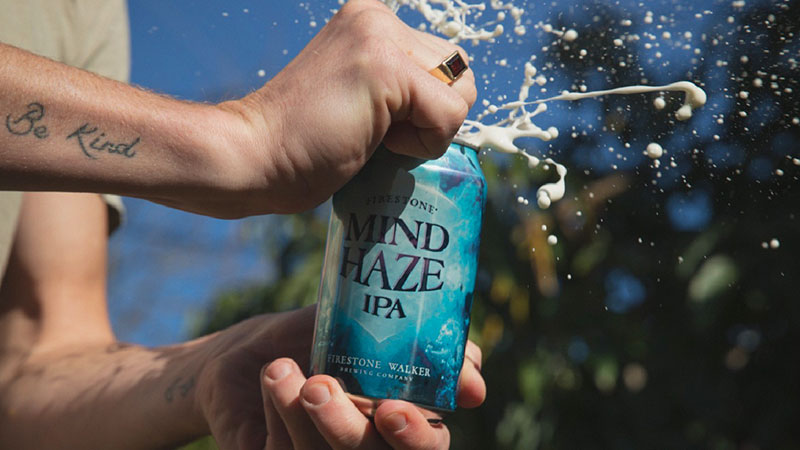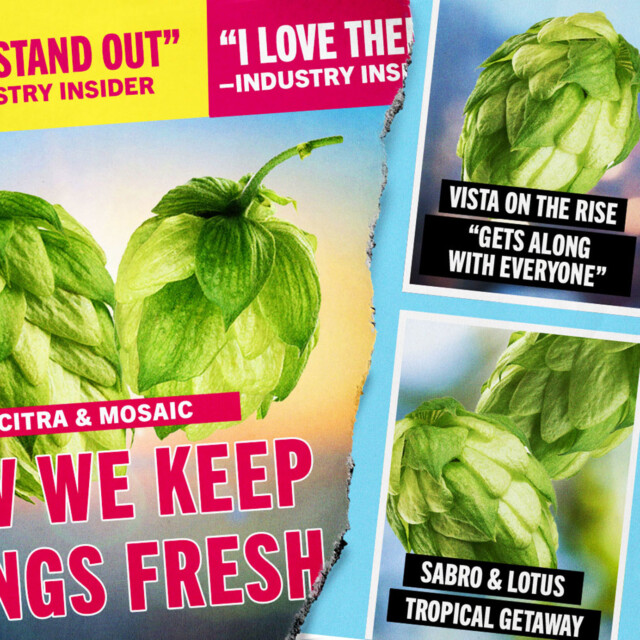The Hallmark Channel has the market cornered on holiday miracles. Each winter, the network magically releases another round of romantic comedies that rarely stray from its feel-good template, much like the hordes of hazy IPAs hopped with Citra and Mosaic.
“It’s a safe bet if you’re making an IPA to use Citra and Mosaic,” says Jeff Tyler, the head brewer and owner of Spice Trade Brewery + Kitchen in Greenwood Village, Colo. “You just can’t screw it up.”
The citrusy-tropical couple even takes top billing in this Hallmark movie meme. “How cute! Citra and Mosaic standing by a Christmas tree!” Actually, there’s Citra and Mosaic by every Christmas tree. Why mess with aromatic success?
For brewers, the duo can serve as the agronomic equivalent of vocal-correction software, letting any IPA become a taproom star. “Citra and Mosaic indeed make any IPA good, can cover a flaw, and basically serve as brewers Auto-Tuning,” says Jeremy Marshall, the brewmaster at Lagunitas Brewing in Petaluma, Calif.
The combination’s ubiquity also leads to opportunity. There are scores of commercial hop varieties grown around the globe, from the Pacific Northwest to Germany, the United Kingdom, the Czech Republic, Australia, New Zealand, and beyond. Researchers and farmers are constantly working to create the next great variety, from Sabro’s Piña Colada profile to the pineapple-and-peach pop of New Zealand’s Nectaron. Brewers are mixing and matching the latest hops, finding fresh new blends to create IPAs with not-so-common scents.
Embracing New American Hop Varieties
Brewing is a business, and it’s smart to give customers guaranteed crowd-pleasers. Burgers, wings, and pizza are brewpub staples, and taplines likely contain an IPA — or two or three — with Citra and Mosaic humming in harmony.
“Shoot, I love Citra and Mosaic,” says Jan Chodkowski, the head brewer at Our Mutual Friend Brewing in Denver. “They stand out.”
The challenge of looking beyond the duo, Chodkowski says, is that many new hops don’t jump out on their own. He trials new hop combos in his Wave Motion rotating IPAs, and one recent standout was Ahhhroma, a variety that evokes pineapple, lime, mango, and pear. It excelled with Australia’s fruity Vic Secret and the pungent, cannabis-like quality of Strata.
Marshall of Lagunitas gets a subtle strawberry note from Strata that plays well with coconut-y Sabro. “So there you go: strawberry coconut Daiquiri,” Marshall says.
“We’ve been liking Vista and finding it to be very complimentary with other hops.”
Sabro can be a divisive hop, somewhat reminiscent of Malibu rum or sunscreen. Skip Schwartz, the head brewer at WeldWerks Brewing in Greeley, Colo., pairs it with Lotus hops (orange Creamsicle), pineapple purée, and toasted coconut in the Piña Colada double IPA. “I wish more people would get on board with this funky combination,” says Schwartz, who recently used the combo in Vacay Everyday, a double IPA showcasing a confidential third hop.

Researchers regularly cross-pollinate hops to create offspring with distinct characteristics. Talus is the daughter of Sabro, and the progeny mixes coconut notes with a pleasant woodiness and an intensely floral, citrusy profile. “It has a truly unique character unlike any other hop,” says Sean Lawson, the founding brewer of Lawson’s Finest Liquids.
The Waitsfield, Vt., brewery just collaborated with Denver’s Crooked Stave on the Lupulin Gumbo IPA that mixes Talus with experimental variety HBC 630 (raspberries, cherries) and Vista (honeydew melon, white peach, papaya), a public variety developed by the USDA’s hop breeding program.
Many modern hops, like Citra and Mosaic, are proprietary varieties that growers must license. Anyone can grow public varieties like Cascade, Cashmere, and Vista, which was released in late 2021. “We’ve been liking Vista and finding it to be very complementary with other hops,” says Jeremy Moynier, the senior manager of innovation and supply chain for Stone Brewing in Escondido, Calif.
At Belleflower Brewing in Portland, Maine, co-owner Nick Bonadies is big on Enigma and BRU-1 for the brewery’s popular Scrugsy IPA. “It’s almost like drinking pineapple juice,” he says. The aroma also evokes cotton candy. “It’s just so deep and rich.”
Deemphasizing Citra and Mosaic is a market differentiator for Firestone Walker. For years, the Paso Robles, Calif., brewery “has intentionally steered away from formulating beers that are Citra- or Mosaic-dominated,” says brewmaster Matt Brynildson. (Firestone Walker instead uses the hops in supporting roles.)
“Mind Haze features a cool combination of Cashmere, which brings a soft peachy aroma and juicy flavor, and Azacca, which when selected properly brings big pineapple-forward tropical notes,” he says. “It melds seamlessly in hazy IPAs brewed with expressive, juicy yeast strains.”
New Zealand Hops Offer Aromatic Alternatives
In recent years, the quality, quantity, and variety of New Zealand hops has drastically increased, in part due to the growth of operations including Freestyle Hops and Clayton Hops.
“The influence of New Zealand hop flavors into American West Coast IPAs is something that we’ve been working on and think is going to be a next frontier in hop flavor,” says Ben Edmunds, the brewmaster at Breakside Brewery in Portland, Ore.
That rings true at San Diego’s Pure Project Brewing, which tests experimental New Zealand varietals via NZ Hops’ Bract Brewing Programme. The brewery recently collaborated on a West Coast IPA called Serpents in the Bramble featuring Nelson Sauvin, known for its Sauvignon Blanc character, and Nectaron’s perfume of pineapple, peaches, and grapefruit. “We’ve been really excited to be on the front line of innovation,” says cofounder and brewer Winslow Sawyer.
“Citra and Mosaic are always going to be a part of the equation and make up one-half of any exciting hop combination.”
Family run McIlhenney Brewing in Alpine, Calif., also favors that one-two New Zealand punch in the rye IPA Muntz. “Nectaron fills any gaps that might be in the Nelson Sauvin profile, and vice versa,” says head brewer Shawn McIlhenney.
Nectaron can build a solid foundation for other hops, says Max Shafer, the brewmaster for Roadhouse Brewing and the Pure Madness Group. He mixed Nectaron with Superdelic, another trending New Zealand hop with an aroma that “punches you in the face with passion fruit, strawberry, and lychee,” Shafer says. The blend led to Superdelic, a bold, punchy, and heady collaborative IPA with Templin Family Brewing in Salt Lake City.

The West Coast pilsner, a well-hopped variation, is also ideal for Nectaron, says Daniel Pearce, the head brewer of Meanwhile Brewing in Austin, Texas. He likes Nectaron with zesty Wai-iti hops. “The simple malt bill and clean lager fermentation lets the hops shine,” Pearce says of the blend of citrus and stone fruit.
Fully replacing Mosaic and Citra might be folly, though. “Citra and Mosaic are always going to be a part of the equation and make up one-half of any exciting hop combination,” says Jude LaRose, a cofounder of Hop Butcher for the World in Chicago.
He likes pairing those leading actors with new costars like Waimea, another New Zealand hop. “It amplifies the bright liveliness of Citra or Mosaic with consonant notes of yellow and orange citrus and an edge of aromatics you might find walking through a forest on a warm day,” he says. (Hop Butcher recently brewed the Orange Fly IPA with Citra and Waimea.)
“An IPA with Citra, Mosaic, and Chinook is probably my favorite.”
Familiar American hops can help make an aromatic difference. “We still love the tried-and-true threesome that we affectionately call ‘the Holy Trinity ’— the Citra, Mosaic, and Simcoe combo,” says James Conery, the innovation brewmaster at Sierra Nevada Brewing in Chico, Calif.
First commercially grown in 2000, Simcoe is an American hop that expresses pine and citrus, a staple in an earlier era of IPAs. Maybe something old can help brewers create an IPA that’s fresh and new. “We’re going back to some more classic varieties,” says Steve Luke, the founder of Cloudburst Brewing in Seattle. He’s been impressed with recent lots of Chinook, its piney, resinous, and grapefruit character aligning well with hazy IPAs. “An IPA with Citra, Mosaic, and Chinook is probably my favorite” trio of hops, he says.
In life, as in beer, matters of taste are always in movement. Fifteen years ago, resinous bitterness was all the rage in IPAs. Today, every IPA is on a permanent tropical vacation, sipping something citrusy and fruity. Fast-forward another 15 years, or maybe just five, and chances are good that new hops will headline that Hallmark meme.
After all, brewers “are flavor chasers,” says Kyle Schug, the lead brewer at Crooked Hammock’s location in Myrtle Beach, S.C. “I’m always on the lookout for new combinations and flavors. Where’s the fun in staying the same?”
